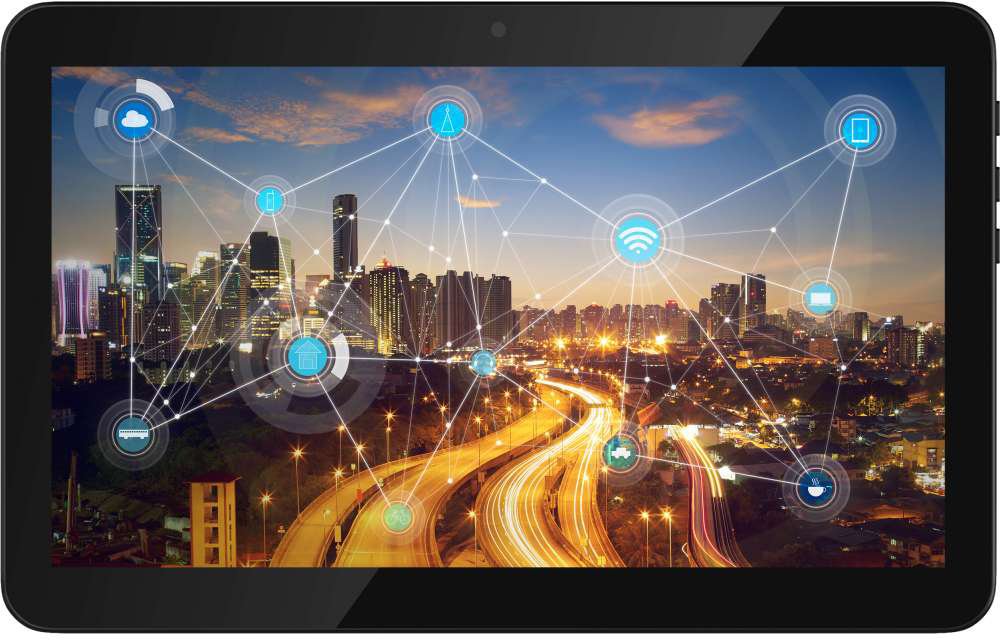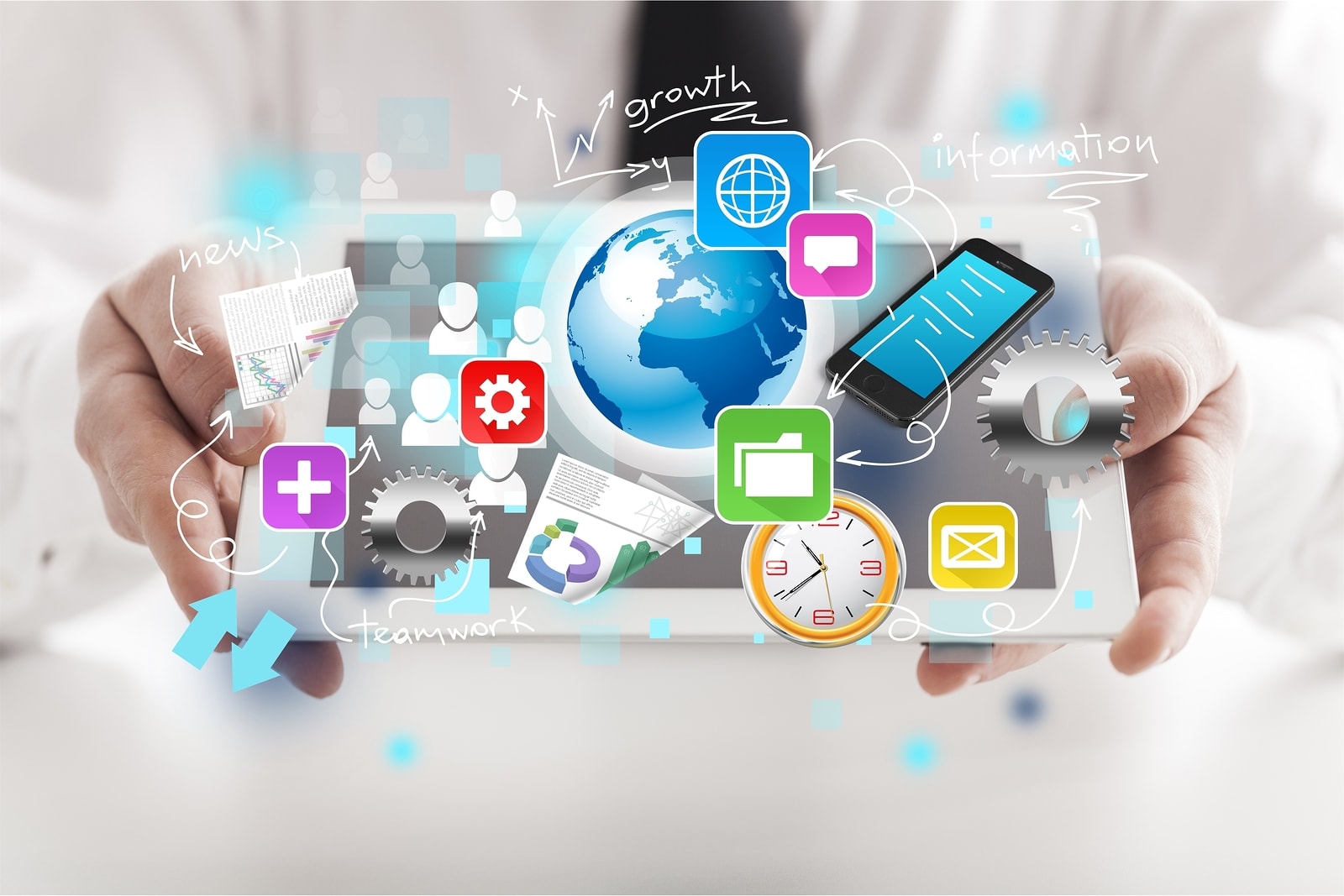IoT Landscape: Connecting the Dots
Introduction
The world is pulsating with the rhythm of IoT, but what exactly is it? Imagine a seamlessly connected ecosystem where devices, data, and daily life converge. IoT, or the Internet of Things, is the intricate web that links physical objects, from smart refrigerators to wearable devices, through the vast expanse of the internet. To comprehend its impact, we’ll delve into the pervasive nature of IoT in our daily lives and take a brisk stroll through its historical roots.
The Building Blocks of IoT

Devices and Sensors
Picture a world where everyday objects transform into intelligent entities. Devices, equipped with sensors, become the eyes and ears of the IoT landscape, collecting data that forms the foundation of its functionality.
Connectivity: Wired and Wireless
The veins of IoT consist of intricate connectivity. Whether through the traditional reliability of wired connections or the liberating freedom of wireless networks, the mode of connection shapes the efficiency and agility of the IoT framework.
Data Processing and Storage:
Behind the scenes, a sophisticated dance of data processing and storage occurs. The colossal volume of information generated by devices undergoes intricate processes, ensuring that valuable insights are extracted and stored securely.
IoT in Action: Real-world Examples
Smart Homes and Connected Devices
Witness the magic of smart homes where lights, thermostats, and even coffee makers sync with your preferences. This is IoT in action, simplifying and enhancing daily living.
Industrial IoT (IIoT)
Industries have embraced IoT to optimize processes. Imagine a factory where machines communicate seamlessly, anticipating maintenance needs and minimizing downtime—this is the Industrial Internet of Things at work.
Healthcare Applications
In healthcare, IoT is a lifesaver. From wearable devices monitoring vital signs to smart pill dispensers ensuring medication adherence, IoT applications are revolutionizing patient care.
The Role of Connectivity
5G and Its Impact on IoT
The introduction of 5G is akin to injecting adrenaline into the veins of IoT. With faster speeds and lower latency, 5G propels IoT into a new era of real-time responsiveness and unparalleled connectivity.
Wi-Fi, Bluetooth, and Other Communication Protocols
Connectivity is a tapestry woven with diverse threads. Wi-Fi and Bluetooth are familiar faces, but there are other protocols knitting the IoT fabric, each tailored to specific needs and contexts.
Challenges in IoT Connectivity
However, with the benefits come challenges. IoT faces hurdles such as signal interference, device interoperability issues, and the need for robust security measures to safeguard interconnected systems.
Data Security in IoT
Cybersecurity Concerns
As the heartbeat of our interconnected world, IoT raises concerns about cybersecurity. The vulnerability of interconnected devices requires robust measures to protect against cyber threats and unauthorized access.
Encryption and Authentication
Encryption becomes the guardian of IoT data, ensuring that sensitive information remains shielded from prying eyes. Authentication mechanisms add an extra layer of security, allowing only authorized entities to access and control devices.
Privacy Implications
With data flowing ceaselessly, the question of privacy arises. Striking a delicate balance between the convenience of IoT and the protection of personal information is crucial to building trust among users.
Edge Computing in IoT
Reducing Latency
Imagine a world where decisions are made at the source rather than traveling to a distant server. Edge computing in IoT reduces latency, enabling faster response times and enhancing the overall efficiency of connected systems.
Enhancing Efficiency
By processing data closer to where it’s generated, edge computing minimizes the strain on networks. This not only optimizes resource utilization but also contributes to a more energy-efficient IoT ecosystem.
Use Cases in Edge Computing
From autonomous vehicles making split-second decisions to real-time monitoring of critical infrastructure, the applications of edge computing in IoT are diverse and impactful.
IoT Platforms: Orchestrating the Symphony

Importance of IoT Platforms
Think of IoT platforms as conductors orchestrating a symphony of devices and data. They provide the infrastructure for seamless communication, data management, and the implementation of applications that bring IoT to life.
Popular IoT Platforms in the Market
In the vast landscape of IoT, certain platforms stand out. From industry giants to agile startups, platforms like AWS IoT, Microsoft Azure IoT, and Google Cloud IoT are shaping the IoT narrative.
Features to Look for in an IoT Platform
Choosing the right IoT platform is crucial. Features such as scalability, security, and compatibility with diverse devices are key considerations for businesses and developers navigating the IoT terrain.
The Intersection of AI and IoT

How AI Enhances IoT Capabilities
Imagine IoT with a cognitive touch. Artificial Intelligence (AI) amplifies IoT capabilities by enabling devices to learn from data, make predictions, and adapt to changing conditions, ushering in a new era of intelligent connectivity.
Machine Learning for Predictive Analytics
In the realm of IoT, machine learning takes center stage. Devices equipped with machine learning algorithms can analyze historical data to predict future trends, facilitating proactive decision-making and problem-solving.
AI-Driven Automation in IoT
Automation becomes intuitive with the fusion of AI and IoT. Smart homes that anticipate your preferences or industrial processes that adapt to changing demands showcase the transformative power of AI-driven automation within the IoT landscape.
Challenges and Opportunities in IoT Implementation
Scalability Challenges
The ever-expanding IoT landscape poses scalability challenges. As the number of connected devices soars, ensuring that systems can handle the growing volume of data and interactions becomes a critical consideration.
Power Consumption and Efficiency
In the quest for efficiency, the power consumption of IoT devices becomes a focal point. Striking a balance between functionality and energy efficiency is paramount to sustainability in the IoT ecosystem.
Future Growth and Innovation
Despite challenges, the future of IoT brims with opportunities. Innovations such as energy-harvesting devices, advanced AI integration, and breakthroughs in connectivity herald a future where IoT continues to evolve and reshape industries.
The Human Element in IoT
User Experience in IoT Applications
Beyond the technical intricacies, IoT is about enhancing the human experience. Intuitive interfaces, seamless interactions, and user-friendly applications are at the core of a positive user experience in IoT.
Addressing User Concerns
IoT’s widespread adoption hinges on addressing user concerns. From data privacy to the intuitive design of IoT devices, understanding and mitigating user apprehensions contribute to building trust in the technology.
Designing for Accessibility
Inclusive design is the heartbeat of IoT. Ensuring that IoT applications are accessible to users of all abilities fosters a connected world where technology becomes a tool for empowerment rather than exclusion.
Regulatory Landscape of IoT

Data Protection Laws
As IoT gathers momentum, regulatory frameworks emerge to safeguard user data. Data protection laws, such as GDPR in Europe and similar regulations worldwide, establish guidelines for the responsible use and handling of IoT data.
Compliance and Standards
Navigating the IoT landscape involves adherence to industry standards. Compliance with established protocols ensures interoperability, cybersecurity, and ethical practices within the IoT ecosystem.
Global Perspectives on IoT Regulations
The regulatory landscape varies globally. Understanding the diverse approaches to IoT regulations worldwide is crucial for businesses and developers operating on an international scale.
Environmental Impact of IoT
Sustainable Practices in IoT
Amidst the technological strides, IoT advocates for sustainability. Implementing eco-friendly practices, from energy-efficient devices to recyclable materials, contributes to reducing the environmental footprint of IoT.
E-waste Management
The surge in connected devices raises concerns about electronic waste. Implementing effective e-waste management strategies becomes imperative to mitigate the environmental impact of outdated or discarded IoT devices.
Balancing Technological Advancement and Environmental Responsibility
Striking a delicate balance between technological advancement and environmental responsibility is the essence of sustainable IoT development. Responsible innovation paves the way for a harmonious coexistence with the planet.
IoT in Agriculture: Cultivating the Future
Precision Farming
In the agricultural landscape, IoT emerges as a game-changer. Precision farming, powered by IoT, allows farmers to monitor and optimize variables like soil conditions and irrigation, maximizing crop yield while minimizing resource usage.
Smart Irrigation Systems
Imagine irrigation systems that respond to real-time weather data. Smart irrigation systems, driven by IoT, ensure efficient water usage, reducing waste and promoting sustainable practices in agriculture.
Enhancing Crop Yield and Sustainability
The synergy of IoT in agriculture extends beyond efficiency to sustainability. From monitoring crop health to optimizing resource allocation, IoT cultivates a future where agriculture evolves into a tech-driven, sustainable endeavor.
Smart Cities: Urban Planning with IoT
Infrastructure Monitoring: IoT transforms cities into intelligent entities. Infrastructure monitoring, through sensors embedded in roads, bridges, and public spaces, enables proactive maintenance and enhances the overall resilience of urban structures.
Traffic Management: In the hustle and bustle of urban life, efficient traffic management is a necessity. IoT-powered systems, from smart traffic lights to predictive analytics, alleviate congestion and pave the way for smoother urban mobility.
Citizen Engagement: Smart cities prioritize citizen engagement. IoT applications, such as public Wi-Fi networks and interactive kiosks, foster connectivity and collaboration, turning cities into vibrant hubs of communal interaction.
Wearables and Personal IoT
Fitness Trackers and Health Monitors
Personal IoT extends to wearables that monitor our health and well-being. From fitness trackers counting steps to health monitors tracking vital signs, wearables empower individuals to take charge of their health.
Smart Clothing and Accessories
The integration of IoT goes beyond wristbands and into the fabric of our attire. Smart clothing and accessories equipped with sensors and connectivity redefine fashion, merging style with functionality.
Privacy Considerations in Personal IoT
While personal IoT brings convenience, it raises privacy concerns. Navigating the intersection of technology and personal space requires robust measures to ensure the confidentiality of sensitive health and lifestyle data.
The Evolution of IoT: From Now to the Future
Anticipated Technological Advancements
The journey of IoT is a continuum of innovation. Anticipated advancements, from quantum computing integration to the proliferation of edge AI, hint at a future where IoT capabilities reach unprecedented heights.
Emerging Trends in IoT
Trends in IoT constantly shape its trajectory. Edge computing, 6G connectivity, and decentralized IoT architectures are among the emerging trends that promise to redefine how we perceive and interact with IoT.
Speculations on IoT’s Role in Future Societies
As IoT evolves, its role in shaping future societies becomes increasingly significant. Speculations range from enhanced urban planning to the integration of IoT in social infrastructure, envisioning a connected and intelligent global community.
Case Studies: Successful IoT Implementations
Highlighting Notable IoT Projects
Real-world examples showcase the tangible impact of IoT. Case studies, ranging from smart cities that optimize resource usage to healthcare applications enhancing patient care, offer insights into successful IoT implementations.
Lessons Learned from Implementation
Behind every success lie valuable lessons. Analyzing the challenges faced and lessons learned from notable IoT projects provides a roadmap for future implementations, fostering continuous improvement within the IoT landscape.
Impact on Respective Industries
The ripple effect of successful IoT implementations extends to industries. Whether in manufacturing, healthcare, or agriculture, the impact of IoT reverberates, optimizing processes, improving efficiency, and enhancing overall industry resilience.
Community and Collaboration in IoT
Open Source Initiatives
Collaboration is the heartbeat of IoT innovation. Open source initiatives, where developers and enthusiasts contribute to shared projects, foster a collaborative environment that accelerates the evolution of IoT.
Collaborative Innovation
The intersection of diverse perspectives fuels collaborative innovation in IoT. From hackathons to industry forums, opportunities abound for individuals and organizations to pool their expertise, driving IoT forward.
Networking Opportunities for IoT Enthusiasts
The IoT community is a dynamic network of enthusiasts. Networking opportunities, whether through conferences or online forums, facilitate the exchange of ideas, knowledge, and the formation of partnerships that propel the IoT movement.
Ethical Considerations in IoT Development
Addressing Bias in IoT Systems
In the realm of interconnected devices, addressing bias is paramount. Ethical IoT development involves mitigating biases in algorithms and ensuring fair and unbiased outcomes, promoting inclusivity and equity.
Ensuring Fair and Inclusive Practices
Ethical considerations extend to ensuring fairness and inclusivity. From design to implementation, cultivating a culture of diversity and inclusivity in IoT development contributes to building a technology landscape that benefits all.
Ethical Decision-Making in IoT
As stewards of technological advancement, ethical decision-making becomes a guiding principle. Balancing innovation with responsibility, IoT developers make choices that prioritize the well-being of users and the ethical development of interconnected systems.
Conclusion
As we conclude our journey through the intricate web of the IoT landscape, it’s evident that we’re standing at the intersection of innovation and connectivity. The dots have been connected, revealing a panorama of possibilities and a future where intelligence and technology converge.
The Ongoing Evolution of IoTThe IoT landscape is not static; it’s a dynamic ecosystem evolving with each technological stride. As we move forward, anticipate the continual evolution of IoT, with new devices, protocols, and applications shaping the connected world.
Envisioning a Connected and Intelligent FutureThe future heralds a paradigm where IoT becomes even more integral to our daily lives. Picture a world where smart cities seamlessly manage resources, and healthcare applications leverage IoT for personalized, efficient care. Envision a connected future where the boundaries between digital and physical blur.
Encouraging Continued Exploration and UnderstandingOur exploration into the IoT landscape is merely a stepping stone. As technology advances, it becomes imperative to foster a culture of continuous learning and exploration. Encourage curiosity, stay informed about emerging trends, and embrace the ever-expanding possibilities that the IoT ecosystem presents.
In the grand tapestry of technological innovation, understanding IoT is not just a destination; it’s an ongoing journey. So, let’s embark on this adventure with an open mind, eager to witness the unfolding chapters of a connected, intelligent future.
FAQs: Understanding the IoT Landscape
What is the Internet of Things (IoT)?
IoT refers to the interconnected network of devices that communicate and share data seamlessly. It transforms everyday objects into smart, data-driven entities, enhancing convenience and efficiency.
How does IoT impact daily life?
IoT stealthily integrates into daily routines, from smart thermostats adjusting to preferences to fitness trackers monitoring activities. It enhances convenience by creating a web of interconnected possibilities.
What is the historical background of IoT?
IoT’s roots trace back to the early days of internet development and the evolution of connected devices. Understanding its history is crucial to appreciating the present and future of IoT.
What are the building blocks of IoT?
The building blocks include devices and sensors that form the core of IoT. These range from simple temperature sensors to sophisticated smart appliances, contributing to the interconnected network.
How does connectivity work in IoT?
Connectivity in IoT involves both wired and wireless communication protocols. The vast network relies on technologies like 5G, Wi-Fi, Bluetooth, and others, presenting challenges that need to be addressed.
What are the real-world examples of IoT in action?
IoT is evident in smart homes with connected devices, industrial applications (IIoT), and healthcare applications. These examples showcase the practical implementation of IoT in diverse settings.
What role does data security play in IoT?
IoT raises cybersecurity concerns, requiring robust encryption, authentication measures, and privacy considerations to safeguard data integrity and user information.
How does AI intersect with IoT?
AI enhances IoT capabilities by enabling machine learning for predictive analytics and driving automation. This intersection contributes to the intelligent functioning of interconnected devices.
What challenges does IoT implementation face?
Scalability challenges, power consumption, and the need for future growth and innovation pose hurdles in IoT implementation. Addressing these challenges is crucial for sustainable IoT development.
How does IoT impact agriculture and smart cities?
IoT revolutionizes agriculture through precision farming and smart irrigation. In smart cities, it monitors infrastructure, manages traffic, and enhances citizen engagement.
What ethical considerations are relevant in IoT development?
Ethical considerations include addressing bias in IoT systems, ensuring fair and inclusive practices, and making ethical decisions throughout the development process.
How can individuals stay informed about the ongoing evolution of IoT?
Encourage continuous learning, stay informed about emerging trends, and embrace the possibilities of IoT. The dynamic nature of technology necessitates an open mind and a curiosity to explore.
Stay Tuned On Our Content
Explore the seamless integration of technology into daily life with our article on Smart Living: How IoT is Revolutionizing Daily Life. Delve into the impact of IoT on everyday experiences, from smart homes to connected devices, and witness the transformation of the modern lifestyle.
Dive deeper into the realm of IoT’s influence on digital marketing in the article titled Abstract for Connecting the Dots: How IoT is Going to Revolutionize the Digital Marketing Landscape for Millennials. Discover insights into the potential shifts in the digital marketing landscape driven by IoT, offering a perspective on how millennials will navigate the evolving digital terrain.





